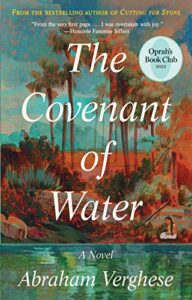10 Book Club Questions For The Covenant of Water by Abraham Verghese
- Posted on
 Abraham Verghese’s epic novel The Covenant of Water is a sweeping saga that spans three generations of the Parambil family in Kerala, South India. The tale weaves together themes of family, faith, love, loss, and the enduring legacy of inherited burdens. Verghese, the author of the critically acclaimed “Cutting for Stone,” has once again crafted a masterpiece that immerses readers in the vibrant and complex culture of Kerala, while exploring the depths of the human experience.
Abraham Verghese’s epic novel The Covenant of Water is a sweeping saga that spans three generations of the Parambil family in Kerala, South India. The tale weaves together themes of family, faith, love, loss, and the enduring legacy of inherited burdens. Verghese, the author of the critically acclaimed “Cutting for Stone,” has once again crafted a masterpiece that immerses readers in the vibrant and complex culture of Kerala, while exploring the depths of the human experience.
Table of Contents

Published: May 2023
Genre: Historical Fiction
Time Period: 1900 to 1974
Chapters: 84
Pages: 720
Star Rating: 4.5
The Covenant of Water Discussion Questions
The Covenant of Water is a novel that demands to be savored, its pages brimming with vivid descriptions, complex characters, and profound explorations of universal themes.
These questions are free of spoilers as much as possible and are designed to foster engaging conversations and invite readers to share their unique perspectives on the novel’s most compelling aspects. Here are some of the questions we have taken from The Covenant of Water Book Club Guide, a comprehensive resource we created to enhance the reading experience with the book. It is filled with discussion questions, games, quotes, food ideas and so much more for both individual readers and book clubs alike. You can get your copy here.
- The “Condition” serves as a central theme throughout the novel, shaping the lives of multiple generations of the Parambil family. How does this inherited disorder serve as a metaphor for the burdens and legacies we inherit from our families?
- Do you believe Elsie’s decision to disappear and create a new life for herself were justified considering the societal stigma surrounding leprosy and her desire to protect her daughter?
- Discuss the evolution of Mariamma’s faith throughout the story. How does her understanding of God and grace shift as she navigates the complexities of life and death?
- The caste system in India plays a significant role in the lives of several characters, particularly Joppan and Shamuel. Analyze the ways in which the novel critiques the social hierarchies and injustices perpetuated by caste. How do characters like Uplift Master and Philipose challenge these entrenched systems?

- The novel explores the theme of motherhood through various characters, including Big Ammachi, Elsie, and Anna Chedethi. Discuss the different ways in which these women embody motherhood and the challenges they face. How does the concept of motherhood evolve throughout the story?
- Consider the various forms of social and political activism portrayed in this book, from Uplift Master’s efforts to improve Parambil to Lenin’s involvement in the Naxalite movement. Discuss the effectiveness of these different approaches to social change. Do you believe that individual actions or collective movements are more impactful in addressing systemic injustices?
- Analyze the different types of secrets kept by characters in the story and the motivations behind their concealment. How do these secrets ultimately bind or divide the family? Discuss the ethical implications of keeping secrets, particularly when they involve matters of health or identity.
- Explore the meanings behind various character names and nicknames, such as “Big Ammachi,” “Baby Mol,” and “Uplift Master.” How do these names reflect the characters’ personalities, roles within the family, and their journeys of self-discovery?
- The novel portrays various forms of disability and illness, including leprosy, cretinism, and the Condition. Analyze the author’s approach to depicting these conditions and the challenges faced by characters living with them. How does the novel contribute to a broader conversation about disability, stigma, and the human experience of illness?
- Music plays a role in the lives of several characters, from the Carnatic music lessons next door to Digby’s bungalow to Mariamma’s preference for opera. Discuss the different ways in which music serves as a source of comfort, inspiration, and cultural identity for the characters.
